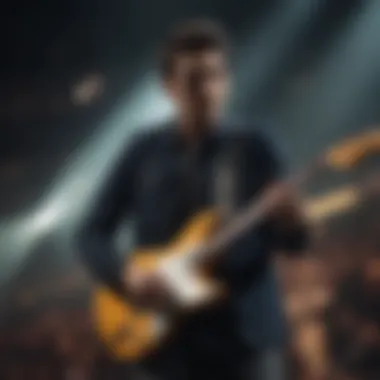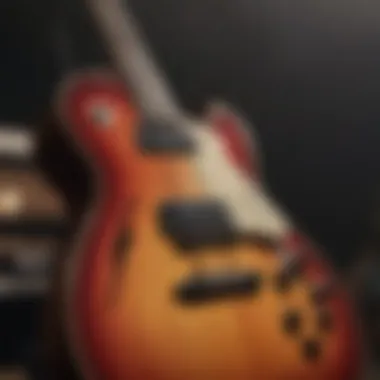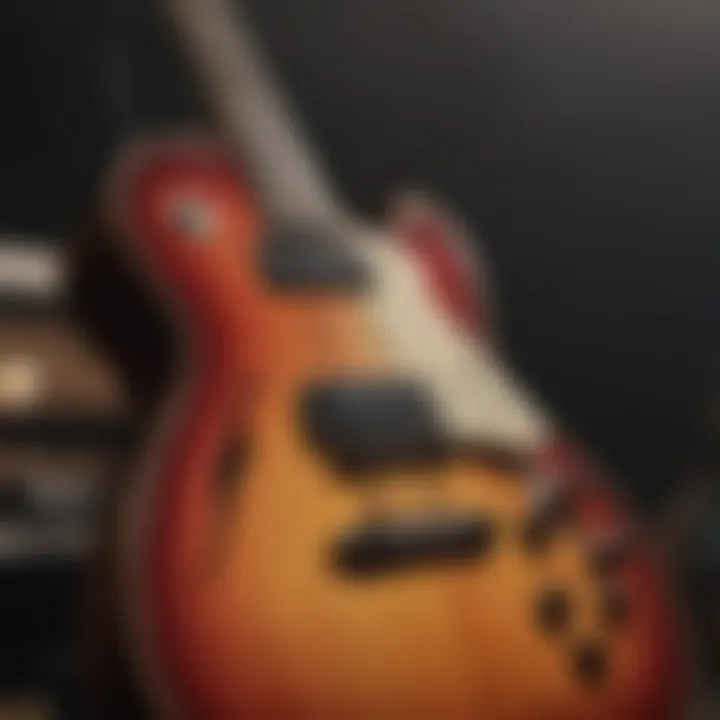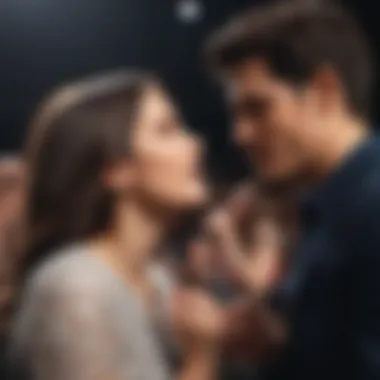John Mayer's Iconic Performances at Madison Square Garden


Intro
Music has a profound ability to connect people, and few artists exemplify this transcendence quite like John Mayer. Over the years, his concerts at Madison Square Garden have become legendary. This iconic venue, known for its rich history and significance in the music world, serves as a backdrop for Mayer's intimate yet grand performances.
In this exploration, we delve into the essence of Mayer's artistry as showcased in these memorable events. We will examine the evolution of his music, the reactions from passionate fans, the memorable setlists, and the cultural implications of his performances.
Artist Profile
Biography and Background
Born on October 16, 1977, in Bridgeport, Connecticut, John Mayer showed musical talent from an early age. His interest in blues music cultivated as he grew up listening to legends such as B.B. King and Stevie Ray Vaughan. After picking up the guitar at age 13, he rapidly progressed, honing his skills and developing a distinctive sound.
Mayer's breakthrough came in the early 2000s with the release of his debut album, Room for Squares. The album received critical acclaim and commercial success, establishing him as a leading voice in contemporary music. His blend of pop, rock, and blues resonated with a diverse audience, and Mayer's signature guitar work and reflective lyrics set him apart.
Major Influences and Inspirations
John Mayer's influences are as varied as his musical style. The incorporation of blues into his rock-oriented framework has roots in his admiration for artists like Eric Clapton and Jimi Hendrix. Moreover, Mayer's lyrical approach often draws from his life experiences and personal relationships, demonstrating vulnerability and emotional depth.
His later works, such as Continuum, showcase a mature sound that highlights his evolution as an artist. Mayer continues to find inspiration in various genres, ensuring that he remains relevant in a constantly changing musical landscape.
"Music is a place of healing and growth; it evolves as we do." - John Mayer
Song Analysis
Theme and Lyrics Breakdown
Mayer's songwriting often reflects introspection and personal growth. Songs such as Gravity and Slow Dancing in a Burning Room delve into themes of love, loss, and the struggle for inner stability. His use of metaphor and narrative creates relatable stories that resonate deeply with listeners.
- Gravity: Explores the struggles of balancing fame and personal integrity.
- Slow Dancing in a Burning Room: A poignant reflection on the complexities of relationships.
Instrumentation and Composition
Mayer's music showcases not only his lyrical prowess but also his exceptional guitar skills. His compositions often blend intricate guitar riffs with rich harmonic structures. This dynamic approach includes elements from various genres, broadening the appeal of his work.
- Guitar Techniques: Mayer employs techniques like fingerstyle playing and blues licks, enhancing the emotive qualities of his songs.
- Song Structure: His songs typically feature bridges and solos that elevate the listening experience, enabling emotional peaks throughout the arrangement.
Attending John Mayer's concert at Madison Square Garden offers more than just a performance; it provides an opportunity to witness musical artistry that evolves with each passing show.
Preface to John Mayer
The exploration of John Mayer establishes a context in which the musical experiences at Madison Square Garden can be understood. Mayer is not just a performer; he is a significant artist whose work impacts the landscape of contemporary music. By introducing his career and style, the article gains depth, offering insights into his evolution and the reasons behind his popularity.
Overview of John Mayer’s Career
John Mayer’s career begins in the late 1990s and spans multiple genres, including blues, rock, and pop. His breakout album, Room for Squares, released in 2001, catapulted him to fame. Songs such as "Your Body Is a Wonderland" showcased his skillful guitar work and insightful lyrics. Mayer's ability to blend different genres sets him apart in a crowded music scene.
Over the years, Mayer has earned numerous accolades, including several Grammy Awards. His collaboration with legends like B.B. King and Eric Clapton demonstrates his respect and standing within the music community. Mayer unfolds a narrative of growth, with each album reflecting different phases of his life and career.
Musical Influences and Style


Mayer's musical influences are diverse. He draws inspiration from artists like Jimi Hendrix, Stevie Ray Vaughan, and Bob Dylan. These varying influences contribute to Mayer's unique style. His guitar playing is celebrated for its technical proficiency and emotional depth. Mayer often combines catchy melodies with thoughtful lyrics, exploring themes of love, loss, and self-discovery.
In live performances, Mayer's style becomes even more evident. His ability to improvise and adapt showcases his roots in blues. Mayer employs a storytelling approach in his songs, inviting audiences into his world. It is this blend of skill and intimacy that makes his concerts memorable and engaging.
Madison Square Garden: An Iconic Venue
Madison Square Garden holds a monumental position not just in New York City, but in the landscape of live music. Its unique architectural design, combined with an impressive capacity, creates an atmosphere that transforms performances into unforgettable experiences. John Mayer, as a major artist, illustrates this intersection of venue and artistry. The blend of his soulful sound and the Garden’s historic charm fosters an environment that resonates deeply with fans. This article seeks to explore how this esteemed venue enhances Mayer's musical expression, underscoring its relevance in his artistic journey.
Historical Significance of the Venue
Established in 1968, Madison Square Garden has hosted a myriad of events, from concerts to esteemed sporting performances. Its role in the evolution of live music is pivotal. The venue has welcomed legendary performers including Billy Joel, Elton John, and the Grateful Dead, which cements its status as a staple in the cultural fabric of America. For John Mayer, playing at the Garden is more than just another concert; it's a rite of passage, a chance to step onto the same stage where musical icons have displayed their craft.
The venue’s historical resonance is notable. It has been the site of transformative performances that have shaped music history. John Mayer’s concerts here echo this legacy, encapsulating moments that are both personal and collective. His unique sound melds seamlessly with the venue’s storied walls, allowing fans to partake in a blend of nostalgia and contemporary artistry.
Madison Square Garden in Music Culture
The cultural impact of Madison Square Garden cannot be overstated. It serves as a benchmark for defining the live music experience. This venue is often seen as the pinnacle of achievement for artists across genres. For Mayer, playing at the Garden reflects not only his success but also his connection with New York City. The significance of this relationship emits from the palpable energy in the crowd, which often contains a blend of dedicated fans and curious newcomers.
"Madison Square Garden is a place where music transcends the ordinary. It’s where every note feels amplified, not just by sound, but by the collective emotion of thousands of voices."
Artists aiming to capture the attention of Madison Square Garden know they have reached a critical moment in their careers. Each performance is an opportunity to build a legacy. The melodies that resonate in this space become part of a larger narrative in the timeline of music events.
In reflection, Madison Square Garden stands as a testament to the power of live music and performance art. It continues to be a site where tradition meets innovation, shaping the careers of artists like John Mayer and offering audiences a shared musical journey.
Memorable Performances
Memorable performances represent a core aspect of John Mayer's artistic identity, particularly at Madison Square Garden. These concerts exemplify the melding of his musical evolution with the rich tapestry of fan experiences. Each performance at this iconic venue is a blend of anticipation, nostalgia, and deep emotional resonance. Mayer's ability to engage and connect with his audience contributes significantly to the lasting impact of these events. They become more than just concerts; they transform into collective memories shared by all who attend.
The importance of analyzing these performances lies not only in the skillful execution of music but also in the unique atmosphere created by Mayer and his fans. The way he adapts his music and style to resonate with the audience reveals his intuitive understanding of live performance dynamics. Understanding these memorable moments can enhance our appreciation of Mayer’s contributions to the music industry, as well as the cultural relevance of his work.
Iconic Concerts at Madison Square Garden
John Mayer's concerts at Madison Square Garden have become legendary for several reasons. One of the most noteworthy events took place on December 16, 2016, during his "The Search for Everything" tour. The energy in the venue was palpable as he performed a mix of classic hits and newer material. Fans felt a sense of intimacy despite the large audience, showcasing Mayer's talent for creating personal connections during live performances.
Another memorable concert occurred on July 12, 2019. Mayer joined forces with The Grateful Dead’s Bob Weir for an unforgettable night. The synergy between these two iconic musicians created an atmosphere of euphoria, resonating deeply with fans who appreciated both their catalogs. The collaboration highlighted Mayer's versatility and willingness to explore different musical territories.
These concerts and others like them highlight Mayer's profound impact on live music culture. His ability to blend various genres and artistic styles during these performances reinforces why he remains a significant figure in the industry.
Setlist Analysis of Key Performances
Analyzing the setlists from John Mayer's performances at Madison Square Garden can provide insights into his artistic evolution. For instance, the setlist from the "The Search for Everything" concert displayed a thoughtful mix of Mayer's commercial hits and experimental tracks. This balance allowed old and new fans to enjoy a comprehensive experience of his musical journey.
Mayer often revisits specific songs and variations of arrangements, which keeps the essence of each performance fresh. The inclusion of tracks like "Gravity" or "Neon" serves not only as a nod to his earlier work but also as a platform for improvisation and deeper artistic expression.
A typical setlist from one of his iconic concerts might contain elements like:
- Opening Acts: Mediated by quiet yet engaging instrumentation.
- Fan Favorites: "Daughters," alongside more introspective songs.
- New Material: Allowing fans to experience his growth as an artist.
- Collaborations: Occasionally, special guests join to add unique flavors.
The interplay of these elements reflects his adaptability and creativity, ensuring that every concert at Madison Square Garden leaves a lasting imprint on the audience.


"Each show is its own adventure, shaped by the collective energy of the moment."
Understanding these aspects of Mayer's performances helps fans and music enthusiasts appreciate the depth of his work and the enduring legacy he constructs with each concert.
Audience Dynamics
Audience dynamics play a crucial role in shaping the live music experience, particularly during performances at venues like Madison Square Garden. Understanding how fans engage with John Mayer during his concerts helps to illustrate not only the emotional connection between artist and audience but also the broader implications of live performances in contemporary music. The distinct characteristics of the crowd, their reactions, and the overall energy in the venue contribute significantly to the atmosphere and can even influence Mayer’s musical delivery.
Fan Reception and Engagement
Fan reception at John Mayer’s concerts is generally characterized by a profound sense of admiration and enthusiasm. The audience is often a mix of long-time followers and newer fans, all drawn together by a shared appreciation of Mayer's artistry. This eclectic mix creates a vibrant and dynamic environment that can shift throughout the performance.
Fans frequently engage with Mayer not just through applause but by singing along, swaying to the music, and displaying their appreciation for key moments. For instance, during his rendition of well-loved tracks like "Gravity" or "New Light," the audience often bursts into unified song, creating a wave of sound that enhances the intimacy of the performance.
Moreover, Mayer's interaction with the crowd adds to the unique experience. He might share personal stories or anecdotes between songs, making the audience feel involved in the narrative of the concert. This type of engagement fosters a sense of community among fans, reinforcing their commitment to Mayer and his music.
The Atmosphere of Mayer Concerts
The atmosphere at a John Mayer concert is typically electric, marked by a captivating blend of excitement and calm introspection. As fans settle into their seats or gather close to the stage, the anticipation builds, punctuated by the sounds of tuning instruments and distant chatter. Once the lights dim and Mayer steps onto the stage, a palpable energy shifts within the venue.
The combination of his emotive guitar work and insightful lyrics envelops the audience, prompting moments of collective reflection and exuberance. The atmosphere can be intensely personal, with many fans closing their eyes, lost in the music, while others may dance freely, embodying the spirit of the night. This duality allows for a deeply communal experience where individual interpretations of songs meet shared moments of connection.
"A concert is not just about the music; it is a shared experience that becomes an integral part of the lives of both the artist and the audience."
Mayer's ability to create an environment where the audience feels like an integral part of the performance further enhances the atmosphere. The use of strategically placed lighting and visuals amplifies this experience, creating an immersive setting that serves to heighten emotional responses. As a result, whether the concert features reflective ballads or up-tempo blues pieces, the audience's dynamics play an indispensable role in shaping the overall experience.
The Evolution of Mayer’s Music
The evolution of John Mayer's music represents a critical aspect of his identity as an artist and his impact on the music landscape. This section examines how Mayer's sound has progressed over the years and the relationships between his musical style, lyrical themes, and live performances. Distilling the essence of his artistic journey provides insights into how he resonates with audiences and adapts to the changing contours of contemporary music.
Musical Shifts Through the Years
John Mayer's career displays a clear trajectory that showcases his adaptability and growth as a musician. From his early days in blues-infused pop rock to his present endeavors in various genres, Mayer's shifts can be clearly observed. Initially, Mayer gained fame with his album Room for Squares, known for its catchy melodies and acoustic vibes. His distinctive guitar work caught attention and established him as a formidable contemporary musician.
As years passed, Mayer embraced various musical styles. The release of Continuum marked a significant pivot towards a more mature sound, where blues elements became more prominent. This transition emphasized his deep respect for traditional blues artists while his own signature style developed. Tracks like "Gravity" or "Waiting on the World to Change" illustrated a newfound depth and introspection in his songwriting.
In subsequent albums such as The Search for Everything and Sob Rock, Mayer incorporated influences from soft rock and pop, showcasing his versatility. These releases not only convey his growth as a performer but also reflect personal experiences, addressing themes such as love, vulnerability, and self-discovery.
Themes Explored in Live Performances
When John Mayer performs live, he transcends mere entertainment, transforming concerts into intimate experiences that connect deeply with audiences. Each performance serves as a canvas on which Mayer paints intricate emotional landscapes. Across his concerts, themes of love, relationships, and introspection feature prominently. The lyrics often delve into personal struggles and triumphs, forging a bond with listeners who see their own experiences reflected in his words.
Live sessions also showcase how Mayer's approach to music changes. His improvisational skills allow him to express differing interpretations of his songs from one show to another. This unique interaction creates an atmosphere filled with anticipation and excitement, where audiences never know what variations they might encounter.
Additionally, Mayer's engagement with his audience during performances elevates the overall experience. He narrates stories behind the songs and shares insights into his creative process, incorporating elements of vulnerability that resonate with fans. This willingness to share personal anecdotes enhances the atmosphere of mutual respect and admiration.
"Mayer's concerts are not just about melodies; they weave the threads of human experience into a tapestry of sound, creating a lasting impact in the hearts of those who listen."
In summary, the evolution of John Mayer's music is integral to understanding his enduring appeal and contribution to modern music. From his stylistic shifts to the themes he explores during live performances, Mayer continually redefines his artistry while maintaining an authentic connection to his audience.


Impact on Contemporary Music
John Mayer's influence on contemporary music can be observed in various dimensions. His musical style incorporates elements from rock, blues, and pop, making him a versatile artist. Moreover, his live performances at venues like Madison Square Garden encapsulate the essence of modern concert experiences. Mayer's approach to songwriting and musicianship resonates with both seasoned artists and emerging talents.
Mayer has become a beacon for aspiring musicians. Through his lyrics and emotive delivery, he encourages a new generation to explore their creative boundaries. Many young artists cite him as a source of inspiration, expressing a desire to emulate his blend of technical proficiency and heartfelt storytelling.
Influence on Emerging Artists
Many emerging artists draw inspiration from Mayer’s work. His ability to seamlessly integrate various genres has opened doors for fresh sounds in the music industry. Young musicians often look to him not just for his guitar skills but also for his songwriting expertise. He has shown that vulnerability in lyrics can resonate with audiences, a lesson many find invaluable.
Mayer’s commitment to authenticity impacts new artists. The way he shares personal stories through his songs encourages them to follow suit. Thus, it fosters a connection between artist and audience that is critical in today’s music landscape.
Contribution to the Blues Genre
John Mayer's contribution to the blues genre is substantial. He carries the torch for traditional blues while making it relevant for contemporary audiences. His deep respect for blues legends is evident in his covers and original work. Notably, the album Continuum showcases his deep blues roots and is a reference point for many musicians.
Mayer's guitar playing style, characterized by expressive bends and soulful licks, has drawn attention from critics and fans alike. Many see him as a modern-day ambassador of the blues, bridging the gap between past and present. His advocacy for blues music has had a lasting effect on music culture, inspiring other contemporary artists to explore this genre as well.
"John Mayer's artistry is a reminder that the blues can evolve while still paying homage to its roots."
In summary, Mayer’s impact on contemporary music is rich and multifaceted. He influences aspiring musicians and keeps blues traditions alive. His work encourages an appreciation for authenticity and musical depth in an ever-changing industry.
The Role of Technology in Live Performances
Technology plays a vital role in enhancing live music experiences. For John Mayer, performing at Madison Square Garden involves not just music, but also a multidimensional experience for his audience. The integration of advanced technology can elevate concerts from mere performance to a captivating spectacle. This includes everything from lighting systems to sound engineering that ensures every note is heard clearly.
Use of Lighting and Visual Effects
Lighting is crucial in any live performance. At a John Mayer concert, intricate lighting designs create a compelling ambience. Lighting complements the mood of the music. For example, softer hues can evoke introspection during ballads, while vibrant, sweeping lights energize the crowd during faster-paced songs.
Visual effects add another layer of complexity. Screens displaying images or videos often reinforce the narrative of the songs, wrapping audiences in a visual storytelling experience. This synergy between music and visuals deepens emotional connections with the audience. The technical setups often include a team that works tirelessly to sync lights with music, creating a showcase that feels both spontaneous and meticulously planned.
Impact of Streaming on Live Events
Streaming has transformed how audiences experience live performances. For many, attending a concert is no longer limited to physical presence. John Mayer's concerts can be streamed live, allowing fans who cannot attend to partake in the experience from home.
This shift has significant implications. It expands Mayer's reach, exposing his music to a broader audience. Engagement with live streams can also foster discussions among fans through social media platforms. However, it raises questions about how this alters the atmosphere of the event itself. Live audiences may feel different knowing their experience exists digitally for others.
The combination of in-person energy and virtual participation creates a hybrid concert experience that both artists and fans navigate.
"The fusion of live performances with technology does not just enhance the visual and auditory experience; it democratizes access to music, making it available to an audience beyond physical limitations."
In summary, technology, particularly in lighting and visual effects, profoundly influences live performances, shaping both the experience of the audience and the artistry of the performer. As we delve deeper into John Mayer's journey, we must recognize how these elements redefine music and live events in contemporary culture.
The End
Reflection on Mayer’s Legacy
John Mayer's legacy is multifaceted. He has influenced artists across genres, from pop to blues. His songs often explore themes of love, loss, and personal growth. Mayer's lyrical depth and guitar skills have set a benchmark for aspiring musicians. As he continues to innovate, Mayer's influence will likely resonate for years to come. His live performances are not just concerts; they are intimate experiences that highlight his musical prowess and emotional connection with fans. This legacy positions him as a cornerstone in contemporary music, deserving recognition for his contributions.
The Future of Live Music Experiences
Looking forward, the landscape of live music experiences is changing. With technology advancing, concerts are becoming more immersive. Streaming services impact how fans engage with performances, offering them the chance to experience shows from anywhere. Mayer's future concerts may incorporate new technologies, enhancing audience interaction and participation. The combination of live and virtual experiences could redefine how artists connect with fans. As the industry evolves, Mayer's adaptation will be key in shaping what live music looks like in the years to come.
"Live music is about connection. It evolves, much like the artist. John Mayer exemplifies this idea through his performances."
Overall, as we reflect on Mayer's past and look to the future, one thing remains certain: his impact on the music industry is indelible, paving the way for both established and emerging artists.







